In today’s world, focusing on the environment has become crucial. Solar power is taking the lead in this effort. By 2027, it’s estimated that solar energy growth will hit 6,000 to 7,000 megawatts (MW) yearly. This shows its huge potential as a sustainable energy source.
This article explores the latest solar energy innovations and the challenges they face. New technology like photovoltaic (PV) advancements and better energy storage options are changing the solar energy world. There’s a strong global push for sustainable, clean energy.
The battle against climate change highlights the need for renewable sources like solar power. We’ll discuss new trends, tech, and solutions pushing the solar energy revolution forward. Yet, we must also look at the obstacles solar faces in becoming our main energy source.
Introduction to Solar Energy
Solar power is getting more popular these days. People are worried about the environment and want clean energy. Solar energy helps by cutting down carbon emissions, not polluting, and using less fossil fuels.
The Rise of Renewable Energy Sources
Solar power is growing fast. This is because the technology is improving, making it cheaper. People are also more aware of the good it does for our planet. By 2030, about a quarter of all electricity will come from renewable sources.
Advantages of Solar Power
Solar energy comes from the sun, so it’s never-ending. It doesn’t add to the bad gases in our air. Solar panels last a long time, over 25 years. This makes them a good choice for the future. The solar industry has been growing about 33% every year for the last ten years, which is a lot.
“Solar power can provide global energy for an entire year with the sun’s power beating down every hour.”
Solar power is becoming even more popular. It’s expected that 60% of new power will be solar by 2025. This good change is happening because solar panels are getting cheaper. So, they will help the world switch to cleaner energy.
Innovations in Solar Technology
In the last few years, the solar energy industry has seen big steps forward. These developments in solar technology have made a real impact. A big step has been in making photovoltaic (PV) cells more efficient. This means they can turn light from the sun into electricity better. The U.S. Department of Energy’s Solar Energy Technologies Office (SETO) has been key in this progress.
Advancements in Photovoltaic Cells
Investments in PV technology by SETO have led to better solar panels. And this has made solar energy more affordable and long-lasting for homes. The work done includes things like the Incubator program and support for small businesses. These have brought in a lot of money that then boosted the solar technology market.
The American-Made Challenges have helped by offering over $100 million in prizes. This has turned new ideas into successful solar businesses. Such efforts are helping more people use solar energy. Not just that, they are also making it look good in our cities.
Building-Integrated Solar Systems (BISS)
Building-integrated solar systems (BISS) are one big change in the solar sector. These systems combine solar panels with building designs. This makes them look nice and also be good for the environment. SETO’s support has pushed forward the making of solar parts for buildings.
Special solar windows, facades, and rooftops are being developed in the U.S. These new products aim to be affordable and powerful. They help make solar energy more common and pleasant to see in cities.
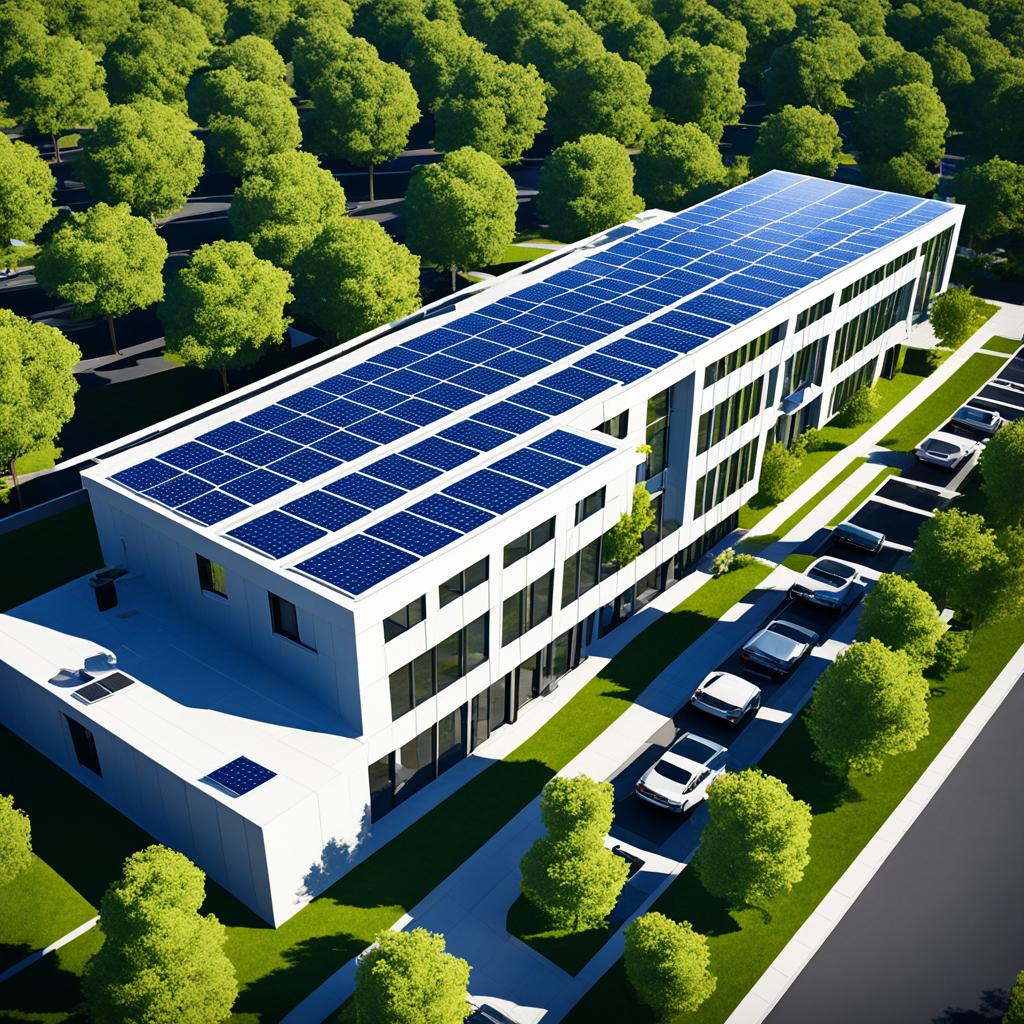

The solar technology field is growing fast. Demand for renewable energy is increasing. As solar energy gets more efficient, cheaper, and part of our everyday buildings, we’re moving towards a better energy future.
Residential Solar Installations
The use of residential solar energy is quickly growing in America. Currently, there are more than a million homes with solar panels. Homeowners are discovering the perks, such as saving money on energy costs, cutting down on their carbon footprint, and increasing their home value.
Until December 31, 2021, a federal tax credit is available for these systems. This credit was 30% through 2019, but it’s now 26% in 2020 and will be 22% in 2021. It’s a big help in making residential solar more affordable for people.
Benefits of Home Solar Power
Home solar power is great for cutting costs on energy bills. On average, adding solar panels increases a home’s value by about $15,000. So, beyond the savings, you’re investing in your property too.
Using solar energy also reduces harmful emissions like CO2. This helps fight pollution and supports a greener, more sustainable planet. Even in areas with less intense sunlight, the US has enough solar power for big cost savings and eco-friendly power.
Many things affect the choice to get a residential solar system. This includes how much power you use, the size of your roof, and how much sunlight your area gets. But, as solar prices drop and more financing options become available, going solar is easier and attractive for many homeowners.
The solar industry is set for a bright future. It can power the average family’s needs and boost home values. Home solar power is key for a sustainable and renewable energy future.
Commercial Solar Implementations
Solar energy goes beyond homes. Commercial solar helps businesses save money. It shows they care about the planet, too. Businesses can enjoy cost savings and promote sustainability with solar power.
Choosing solar power decreases a business’s energy costs. It lessens their use of regular power. Commercial solar also helps meet green rules. It boosts their image as green leaders. This draws eco-friendly customers and investors, helping the business grow.
At first, commercial solar costs a lot. But, the savings and tax benefits add up over time. Using solar is not just good for the Earth. It’s a smart move for a business’s future.
“Investing in commercial solar power can be a game-changer for businesses, delivering both financial and environmental benefits. It’s a win-win solution for companies seeking to reduce their carbon footprint and enhance their bottom line.”
The future looks bright for commercial solar. As tech gets better, these systems will be more affordable. They will become even more appealing to businesses. Commercial solar is set to change how companies power their work. And it will help make the planet greener and more sustainable.
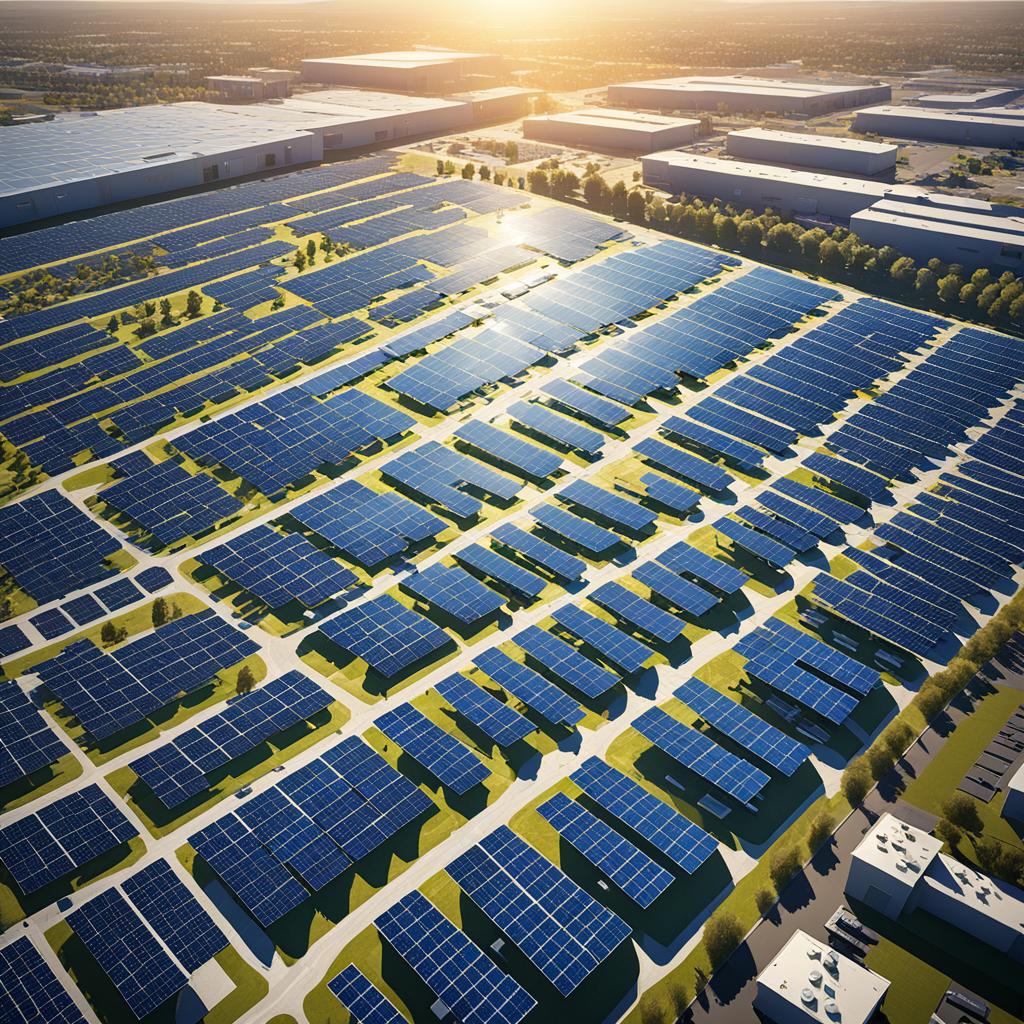

The Future of Solar Energy
The shift to renewable energy makes the future of solar power look bright. New technology makes solar energy more sustainable, efficient, and easy to get. This includes solar panels that are flexible and thin, aimed at improving how we catch the sun’s power.
Flexible and Ultra-Thin Solar Panels
Solar panels that are flexible and thin are an exciting development. They can fit into the design of buildings and windows. This change makes solar power less obtrusive and more adaptable, aiming for broader use in homes and businesses.
Higher Efficiency Materials and Conversion Rates
Enhancements in solar cells are also happening. Scientists are looking at new materials and techniques, like organic molecules and perovskite chemistry. These could make solar panels work even better than traditional ones. This could lead to significant and positive changes in how we make and use renewable energy.
A study forecasts solar energy will make up 45% of US electricity by 2050 if the energy system is fully clean. This shows how vital solar energy will be in the future. It highlights the need for more innovation and tech development.
“The future of solar energy is undoubtedly bright, with the potential to transform the way we power our world. From flexible panels to higher efficiency materials, the industry is constantly pushing the boundaries of what’s possible, bringing us one step closer to a sustainable energy future.”
Renewable Energy Storage Solutions
The world is moving towards renewable energy. Reliable energy storage is now more important than ever. Battery energy storage systems (BESS) are a key player in this shift. They help solve the problem of variable energy from sources like solar power.
BESSs store extra energy when it’s plentiful and release it when needed. This helps keep the energy supply stable. Prismecs proved this by using a 7 MW BESS with a 28 MWh capacity. They showed how cutting-edge energy storage technologies help use renewable energy sources better.
Battery Energy Storage Systems
The move to renewable energy makes BESS and other storage vital. They store energy chemically and turn it back into power as required. Lithium-ion batteries are a common choice. They keep improving in efficiency, storage, and cost.
The Moss Landing Energy Storage Facility in California has the world’s biggest BESS. Since January 2021, a 300-megawatt lithium-ion battery is operational here. This project shows the huge potential for BESS to make grid operations better. It helps renewable energy sources fit in smoothly.
| Energy Storage Technology | Key Attributes |
|---|---|
| Pumped Hydroelectricity | Uses water’s energy to store power. It’s been a reliable option for a long time. |
| Hydrogen Storage | Makes hydrogen gas for storage. It can keep a lot but isn’t as efficient as some. |
| Flywheel Energy Storage | Spins wheels to store energy. It’s very durable and packs a lot of energy in a small space. |
| Compressed Air Energy Storage | Keeps air or gas under pressure. It’s good for balancing the power grid. |
| Pumped Heat Electrical Storage | Uses extra renewable energy to heat, cool or make power. This method focuses on being efficient with energy. |
The energy storage market is changing fast. With various technologies and better battery energy storage systems, we’re making room for renewable energy sources. These storage solutions are crucial in speeding up our shift to sustainable and efficient energy.
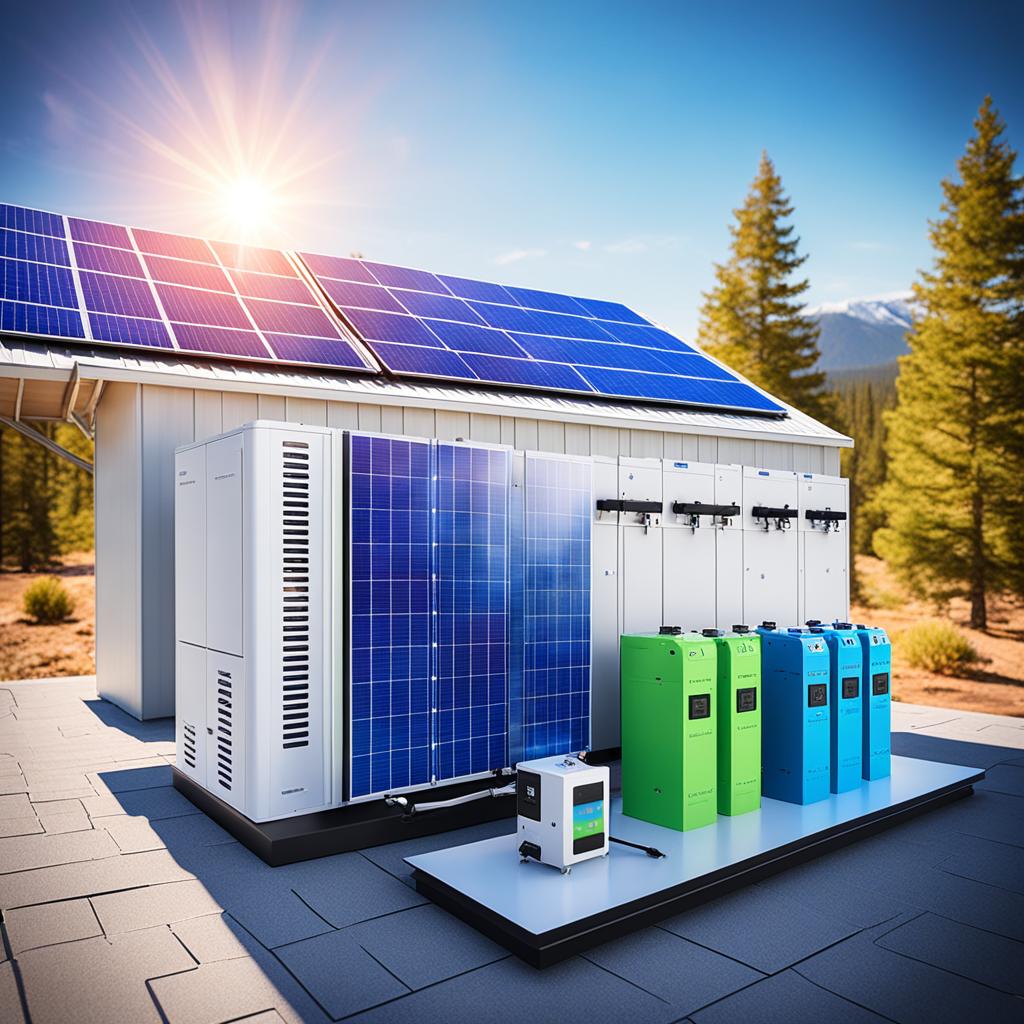

Microgrids and Localized Energy Solutions
The world of renewable energy is changing fast, and microgrids are at the forefront. These are small, local energy systems. They can work alone or with the main power grid. They make, share, and save energy in a smaller area. This brings reliable power, independence, and support to communities facing tough times with the main grid.
Making their way into far-off places, microgrids spark economic growth. They strengthen a community’s ability to bounce back from disasters. The global market for microgrids is growing, expected to top $168.64 billion by 2032. This shows how important these local energy sources are in moving towards renewable power.
Microgrids fit right in with areas blessed with constant winds or the sunny ones, too. Wind-powered ones thrive in places with a lot of wind. Solar ones keep costs low and don’t need much upkeep. And for cities and healthcare places, fuel cell microgrids are a top pick, using energy effectively and cutting down on pollution.
Adding Combined Heat and Power (CHP) to microgrids helps cut back energy waste. This means lower bills and less pollution. Using clean fuel like green hydrogen with fuel cells makes microgrids pollution-free. It’s a big step towards an energy future that’s good for the planet.
Even though microgrids are gaining traction, they only supply a tiny bit of the U.S.’s power, less than 0.3 percent. But, their role is growing. In the last four years, their capacity went up nearly 11 percent. The U.S. now has over 690 microgrids, together packing a punch of nearly 4.4 gigawatts.
The need for ways to keep the lights on in hard times and cut down on pollution is rising. Microgrids are set to take on a bigger part in providing clean, reliable power. They offer a way for communities and businesses to reduce their carbon footprint. While ensuring they have a steady and independent source of energy.
Smart Grids: Optimizing Energy Efficiency
The power grid is changing with new smart grid technologies leading the way. These new systems change how we make, deliver, and use energy. They help us use energy better, cutting down when it’s most needed through demand-response actions.
Smart grids use data and artificial intelligence to know when we’ll need more energy. By doing this, they balance the power system, making sure it doesn’t overload. This is key for adding more renewable energy sources, like solar power, and making a sustainable future.
These newer, smarter power grids also mean less downtime thanks to real-time checks and fixing issues before they cause problems. They make the power system more stable and cut the chances of blackouts. Adding things like solar panels at homes and other local power sources means we don’t have to rely as much on big power companies.
In the big picture, smart grids are vital for moving to a future powered by renewables. They bring together the tech that both companies and regular people can use. Working together, we can make our energy use smarter, greener, and more reliable.
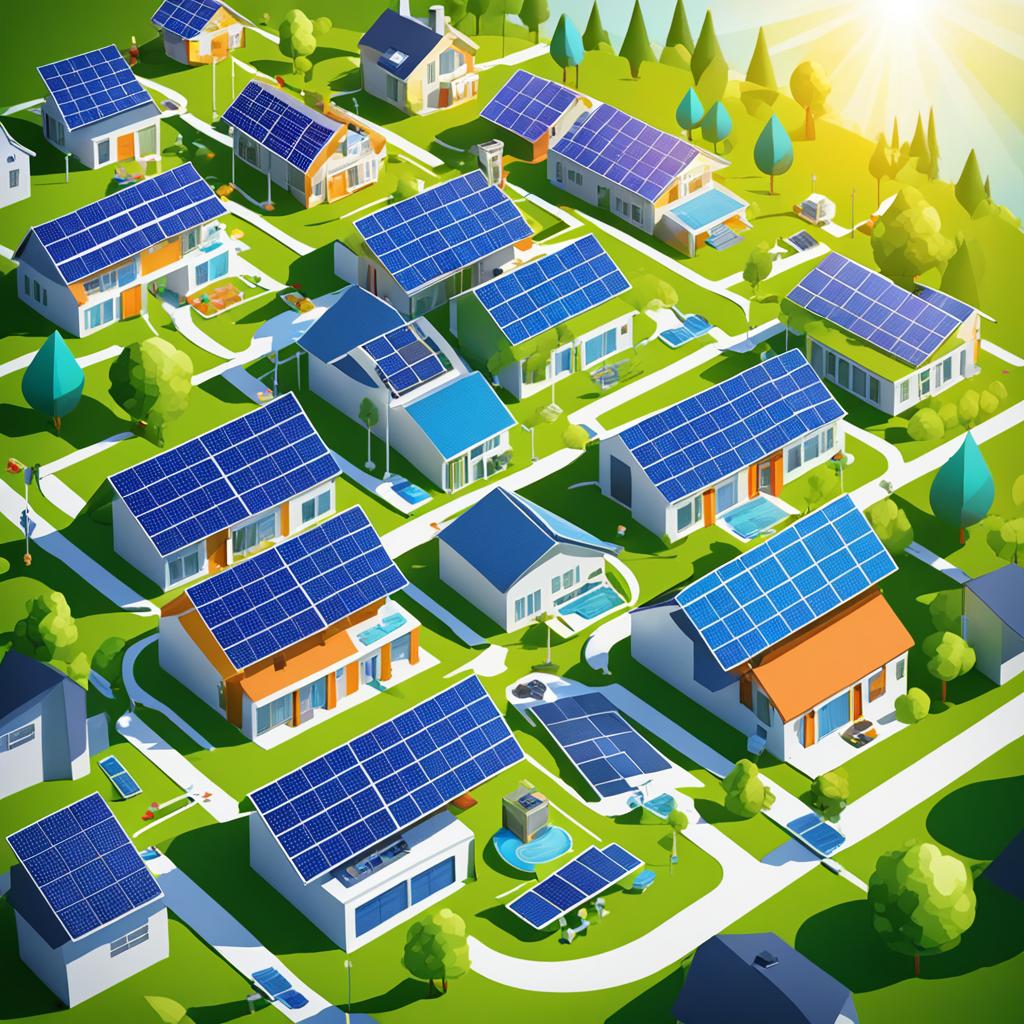

“The integration of smart grid technologies will be essential in maximizing the benefits of renewable energy sources and facilitating the transition towards a more sustainable energy landscape.”
Challenges in the Solar Energy Transition
The solar energy path is tough but full of promise. An issue is that we can’t depend on the sun shining every day. This makes the power supply unstable. But, we’re making better batteries to store extra solar power from sunny days.
Intermittency and Storage Limitations
Sometimes, the sun isn’t out, like on cloudy days or at night. This means solar power can be here one moment and gone the next. To keep power steady, we need advanced energy storage. Luckily, technologies are growing to handle this, storing solar power for later use.
Infrastructure Upgrades
Getting more solar power into our lives means our systems need to change. The way we distribute energy through grids needs to do better with renewables. We need to update these systems and build new ways to store and manage energy. This is key for a reliable solar future.
To truly shift to solar power, we have to tackle these hurdles head-on. It’s all about working on solar power’s downsides like its highs and lows and making our systems match. Doing this will move us closer to a future powered by clean, solar energy.
“The transition to a renewable energy-powered future is not without its challenges, but with continued innovation and investment, we can overcome these obstacles and create a more sustainable, resilient, and reliable energy system for generations to come.”
Career Opportunities in the Solar Industry
The solar industry careers are growing fast. This offers many chances for those who want to help shift to green energy. Solar engineers create and improve solar systems. They put these systems in buildings and other places. Solar installers are key in setting up and taking care of solar panels. Sales and marketing pros help sell solar energy to people and businesses. They make a big difference. Researchers and policy experts also push the field forward. They do studies to make solar tech better. They help with laws and rules on solar energy.
Want to work in solar energy jobs? You’ll need to know a lot about solar energy and how it works. Also, soft skills like talking well, solving problems, and working with others matter. Getting the right degrees and certifications can make it easier to get a job in the solar industry.
| Career Opportunity | Key Responsibilities | Required Skills and Education |
|---|---|---|
| Solar Engineer | Design and develop efficient solar energy systems, integrate them into building designs and infrastructure | Bachelor’s or master’s degree in engineering, knowledge of solar energy technologies, electrical engineering, and project management |
| Solar Installer | Install and maintain solar panels and systems, ensure optimal performance | Technical training or certification in solar installation, knowledge of electrical systems and safety protocols |
| Solar Sales and Marketing | Promote and sell solar energy solutions to residential and commercial customers | Strong communication and sales skills, understanding of solar energy technologies and financing options |
The solar industry is perfect for those who love renewable energy. It’s growing fast, and there will be even more jobs in the future. This is an exciting time to join the solar world.
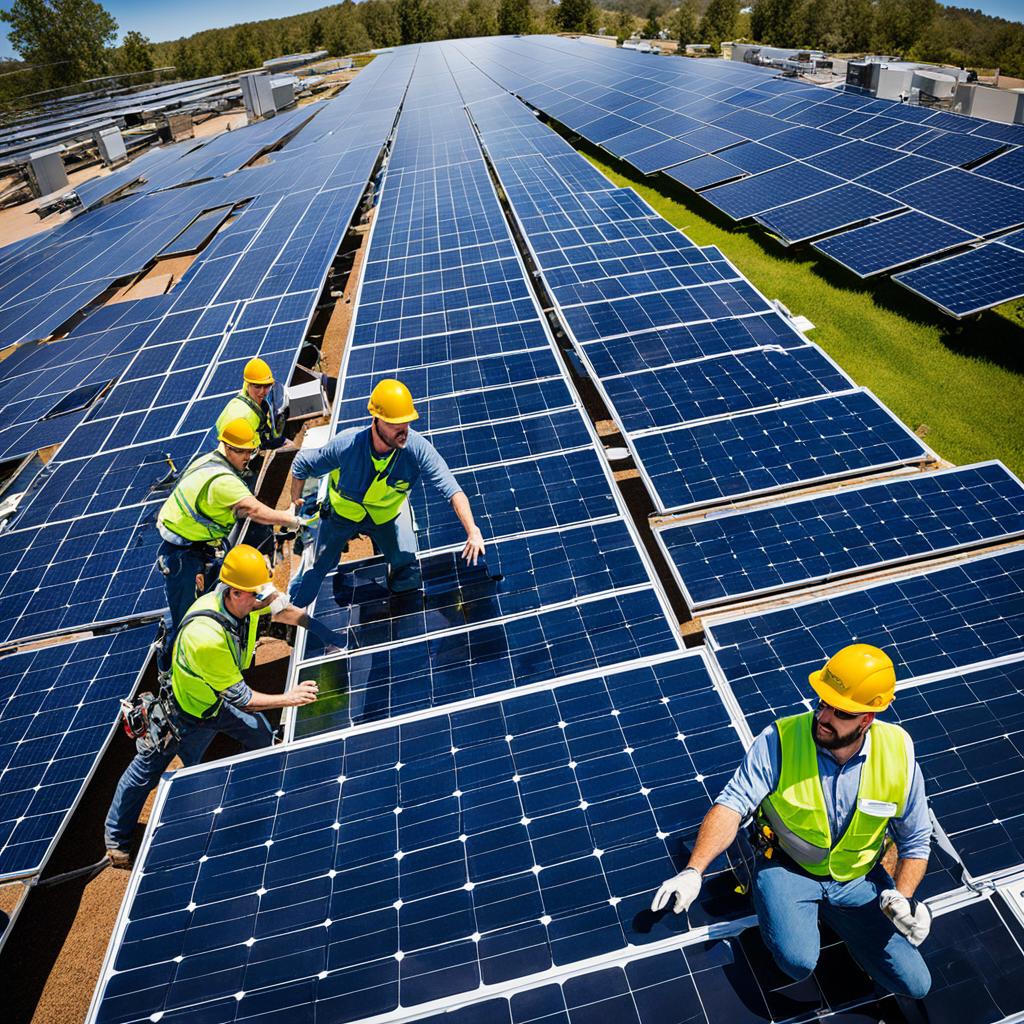

Emerging Solar Technologies
The solar energy field is always growing, with new innovators and researchers finding new paths. Thermophotovoltaics (TPV) and bifacial PV modules are two such technologies. They’re likely to change renewable energy in the future.
Thermophotovoltaics (TPV): Harnessing Heat to Generate Electricity
Thermophotovoltaics (TPV) is a new way to use the sun’s light. It captures sunlight, keeps the heat, and then changes it into electrical power with TPV cells. This way combines different materials for solar panels. It can almost match the efficiency of the common solar panels made of silicon. Recent studies show TPV can be over 25% efficient, indicating a bright future for solar power.
Bifacial PV Modules: Capturing Light from Both Sides
Bifacial PV modules are another new technology. They can get light from the front and back of the panel. This means they can use space better, especially in areas with little room or that reflect light. The market for these panels has grown due to a need for more clean energy, better efficiency, and lower costs.
New solar technologies, like flexible panels and materials that work better, are going to change the solar industry. They will help make our energy use more sustainable.
“Solar technology was declared the ‘cheapest source of electricity in history’ by the International Energy Agency in 2020.”
As we move more towards renewable energy, these new solar technologies will be key. They will help make clean, sustainable power more available. With more work and new ideas, solar energy’s future is very promising.
Conclusion
The future of solar energy looks very bright. There are many new advances happening. These changes are making our energy use more sustainable. For example, we now have flexible and super-thin solar panels. And we’re finding better ways to turn sunlight into electricity. The solar energy world is always getting better and finding new limits. We’re also finding great ways to store the energy and use it more efficiently.
In the U.S., we’re turning more towards different types of clean energy. This is especially true in places like the American Northwest. Even though it’s a big challenge, we have new ways to make it work. Thanks to better technology and new ideas, we can use solar power to meet more of our energy needs. This helps cut down on harmful CO2 pollution.
The outlook for solar energy is very positive. If we keep investing and pushing for new ideas, solar power will be a key player in our energy future. It could help us build a greener, more reliable energy system for the country.
Source Links
- https://prismecs.com/blog/renewable-energy-transition-challenges-harnessing-innovation-for-a-sustainable-future
- https://www.mdpi.com/1996-1073/16/18/6456
- https://www.linkedin.com/pulse/harnessing-power-sun-exploring-solar-energy-its-role-sanitha-taab
- https://insights.cincoland.com/blog/an-introduction-to-solar-energy
- https://www.nationalgrid.com/stories/energy-explained/how-does-solar-power-work
- https://justenergy.com/blog/introduction-to-solar-power/
- https://www.energy.gov/eere/solar/connect-dots-solar-innovation
- https://www.energy.gov/eere/solar/solar-energy-innovation-network
- https://www.taradigm.com/8-innovations-in-solar/
- https://www.energy.gov/energysaver/benefits-residential-solar-electricity
- https://www.energy.gov/eere/solar/homeowners-guide-going-solar
- https://www.seia.org/solar-industry-research-data
- https://suncityenergy.com/solar-panels-for-commercial-buildings/
- https://www.hoymiles.com/resources/blog/the-commercial-solar-installation-guide-a-brief-introduction/
- https://www.greenlancer.com/post/benefits-of-solar-panels-for-commercial-buildings
- https://www.nrel.gov/news/program/2022/building-a-solar-powered-future.html
- https://arka360.com/ros/future-of-solar-energy-predictions/
- https://tamesol.com/future-of-solar-energy/
- https://www.nationalgrid.com/stories/energy-explained/what-is-renewable-energy-storage
- https://cleanpower.org/facts/clean-energy-storage/
- https://blog.rgbsi.com/6-storage-technologies-renewable-energy
- https://www.bloomenergy.com/blog/what-are-microgrids/
- https://www.c2es.org/content/microgrids/
- https://www.globalpwr.com/microgrids-the-future-of-localized-energy-solutions/
- https://www.forbes.com/sites/forbestechcouncil/2024/06/25/15-ways-smart-grids-will-soon-transform-the-energy-landscape/
- https://www.ibm.com/blog/optimizing-energy-production-with-the-latest-smart-grid-technologies/
- https://www.frontiersin.org/articles/10.3389/fenrg.2023.1283026
- https://www.wri.org/insights/clean-energy-progress-united-states
- https://www.iea.org/reports/renewable-energy-market-update/challenges-and-opportunities-beyond-2021
- https://www.aljazeera.com/economy/2024/3/7/whats-slowing-down-americas-clean-energy-transition-its-not-the-cost
- https://www.energy.gov/energysaver/explore-solar-energy-careers
- https://www.bls.gov/green/solar_power/
- https://green.org/2024/01/30/solar-energy-career-opportunities-and-paths/
- https://www.greenlancer.com/post/solar-panel-technology-trends
- https://www.solarreviews.com/blog/solar-panel-technologies-that-will-revolutionize-energy-production
- https://metropolismag.com/viewpoints/the-next-generation-of-solar-energy/
- https://www.energy.gov/articles/chapter-11-summary-and-conclusions
- https://link.springer.com/chapter/10.1007/978-981-287-462-7_8
- https://personal.ems.psu.edu/~fkd/courses/cause2000/SemesterReports/NWmacro/Conclusion.html
